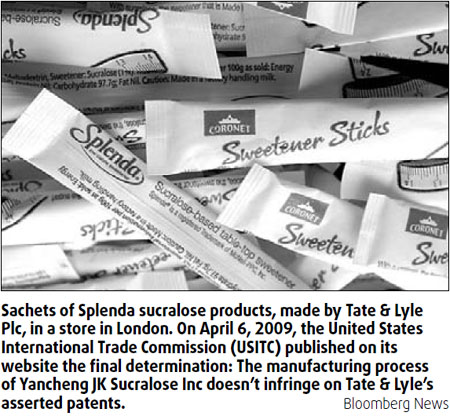ITC Ruling Sweet for JK Sucralose

The US International Trade Commission (USITC) has made a final determination that the manufacturing process used by Yancheng JK Sucralose Inc, a Jiangsu province-based sucralose manufacturer, does not infringe on the patents of US company Tate & Lyle Inc, which filed a complaint with the ITC two years ago, according to a USITC website statement on April 6, 2009.
JK Sucralose Inc is the first and still the only company in China to take the initiative to join a USITC investigation: The company spent about $3.3 million on the investigation, and has finally overcome the accusation of a big international sweetener against Chinese companies and products in the sucralose sector.
Sucralose is a zero-calorie sugar substitute approximately 600 times as sweet as sucrose (table sugar), twice as sweet as saccharin, and 3.3 times as sweet as aspartame. Unlike aspartame, it is stable under heat and can be used in baking or in products that require a longer shelf life. The commercial success of sucralose-based products stems from their favorable comparison to other low-calorie sweeteners in taste, stability and safety.
In the US, a bulked-up product designed for domestic use and of similar appearance to granular sugar is sold under the names Splenda and SucraPlus. Sucralose was first approved for use in Canada in 1991.
Subsequent approvals came in Australia in 1993, New Zealand in 1996, the United States in 1998 and the European Union in 2004.
As of 2008, it had been approved in over 80 countries, including Mexico, Brazil, China, India and Japan. It can be found in more than 4,500 food and beverage products.
According to ITC's statement, Tate & Lyle Technology Limited of London, United Kingdom and Tate & Lyle Sucralose Inc of Decatur, Illinois, the United States (combined as Tate & Lyle Corp) filed a complaint with the ITC against three Chinese sucralose manufacturing enterprises for their sucralose and downstream products, and 25 other trading companies home and abroad on May 10, 2007.
The complaint alleged violations of section 337 of the Tariff Act of 1930 in the importation into the United States, the sale for importation, and sale within the United States after importation of sucralose, sweeteners containing sucralose, and two related intermediate compounds thereof by reason of infringement of various claims of United States Patent Nos. 4,980,463 ("the 463 patent"); 5,470,969 ("the 969 patent"); 5,034,551 ("the 551 patent"); 5,498,709 ("the 709 patent"); and 7,049,435 ("the 435 patent").
To uphold its brand's market share and public image in the international sweetener market, Yancheng JK Sucralose Inc chose Fish & Richardson, a law firm in the US practicing exclusively in the areas of intellectual property, to handle the case.
JK Sucralose submitted an application to the ITC for getting involved voluntarily in the lawsuit on July 5, 2007, and it was approved by the ITC on Aug 15, 2007.
On Sept 22, 2008, ITC put a notice on its official website: In accordance with ITC's procedure, no violation of section 337 was found in JK Sucralose's export product business to the US market.
On April 6, 2009, ITC published on its website the final determination: The manufacturing process of Yancheng JK Sucralose Inc doesn't infringe on Tate & Lyle's asserted patents.
The IPR infringement case captured wide attention, and experts called JK Sucralose Inc's victory a positive example for Chinese companies to compete in overseas markets by standing up for themselves on IPR issues.
"The JK Sucralose case has set an example for export-oriented Chinese companies," said Liu Baocheng, director of the International Business Ethics Center of the University of International Business and Economics. "It reminds enterprises that when they set up overseas strategies, they should combine market and sales with IPR strategy, to defend the IPR risk."
An Lijun, president of JK Sucralose Inc, suggested that whenever an enterprise encounters an international patent conflict, it should:
Face it with a positive attitude and defend its own rights and interests;
Apply actively for IPR protection from both home and abroad;
Be acquainted with international rule of IPR, and use the international market accordingly.
(China Daily 04/20/2009 page11)
2013-07-17 Print
Print